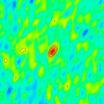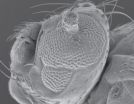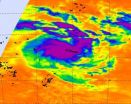Mercyhurst University study probes impact of climate change on ectotherms
2012-12-13
(Press-News.org) A new study by biologists at Mercyhurst University focuses on the influence of climate change, particularly warmer winters, on the survival and potential fecundity of cold-blooded animals.
Cold blooded animals, or ectotherms, do not have an internal mechanism for regulating body temperature. Instead, they rely on solar energy captured by the environment.
The purpose of the Mercyhurst study, a collaboration of Michael Elnitsky, Ph.D., assistant professor of biology; and students Drew Spacht and Seth Pezar, is to assess the current and future impacts of climate change on the overwintering energetics and microenvironmental conditions of the goldenrod gall fly (Eurosta solidaginis). Larvae of the goldenrod gall fly have long served as model organisms for studying the strategies used by freeze-tolerant animals for winter survival.
"We used historical temperature data to estimate the overwintering (November through March) energy use of larval gall flies," Elnitsky said. "Based upon the relationship between metabolic rate and temperature, the estimated energy utilization during winter has increased by more than 30 percent over the last 50 years."
Further, with continued climate change, each additional 1 degree C rise in temperature during winter is projected to increase energy use by 12 percent. The consequence of this is that the amount of energy remaining at winter's end directly determines how many offspring the goldenrod gall fly can produce.
"Unlike some other insects that are benefitting from a changing climate, goldenrod gall fly populations would be predicted to decline," Elnitsky said.
The research team has begun similar assessments of the impacts of a changing winter climate for other arthropods, such as deer ticks (Ixodes scapularis) that transmit Lyme disease bacteria and the hemlock woolly adelgid (Adelges tsugae), an invasive insect destroying hemlock forests throughout the eastern U.S.
The Mercyhurst group presented their research at the annual meeting of the Entomological Society of America (ESA) in Knoxville, Tenn., last month. Spacht of Erie and Pezar of Madison, Ohio, were awarded the President's Prize in the Physiology, Biochemistry and Toxicology section for their poster presentation. The President's Prize is the award given to the top undergraduate presentation in each section at the conference, which was attended by more than 4,000 scholars.
INFORMATION: END
ELSE PRESS RELEASES FROM THIS DATE:
2012-12-13
A specific pattern of neuronal firing in a brain reward circuit instantly rendered mice vulnerable to depression-like behavior induced by acute severe stress, a study supported by the National Institutes of Health has found. When researchers used a high-tech method to mimic the pattern, previously resilient mice instantly succumbed to a depression-like syndrome of social withdrawal and reduced pleasure-seeking – they avoided other animals and lost their sweet tooth. When the firing pattern was inhibited in vulnerable mice, they instantly became resilient.
"For the first ...
2012-12-13
Back in January, a new X-ray source flared and rapidly brightened in the Andromeda galaxy (M31), located 2.5 million light-years away. Classified as an ultraluminous X-ray source (ULX), the object is only the second ever seen in M31 and became the target of an intense observing campaign by orbiting X-ray telescopes -- including NASA's Swift -- and radio observatories on the ground. These efforts resulted in the first detection of radio-emitting jets from a stellar-mass black hole outside our own galaxy.
A ULX is thought to be a binary system containing a black hole that ...
2012-12-13
Researchers at Michigan State University have discovered a protein that does its best work with one foot in the grave.
The study, which appears in the current issue of the Journal of Biological Chemistry, focuses on the nontraditional lifestyle of Retinoblastoma tumor suppressor proteins, which could lead to new ways to treat cancer.
"Retinoblastoma proteins are unique in that they use controlled destruction to do their jobs in a timely but restrained fashion," said Liang Zhang, a lead author and MSU cell and molecular biology graduate student. "This is an unusual way ...
2012-12-13
A drug that works through the same brain mechanism as the fast-acting antidepressant ketamine briefly improved treatment-resistant patients' depression symptoms in minutes, with minimal untoward side effects, in a clinical trial conducted by the National Institutes of Health. The experimental agent, called AZD6765, acts through the brain's glutamate chemical messenger system.
Existing antidepressants available through prescription, which work through the brain's serotonin system, take a few weeks to work, imperiling severely depressed patients, who can be at high risk ...
2012-12-13
COLUMBUS, Ohio – A new study of the batteries commonly used in hybrid and electric-only cars has revealed an unexpected factor that could limit the performance of batteries currently on the road.
Researchers led by Ohio State University engineers examined used car batteries and discovered that over time lithium accumulates beyond the battery electrodes – in the "current collector," a sheet of copper which facilitates electron transfer between the electrodes and the car's electrical system.
This knowledge could aid in improving design and performance of batteries, explained ...
2012-12-13
The date 12-12-12 may be numerically significant, but for the residents of American Samoa and Fiji in the South Pacific Ocean, it means a newborn tropical storm named Evan is causing problems. NASA's Aqua satellite and NOAA's GOES-15 satellite both captured imagery of the newborn storm's cloud cover.
Tropical Storm Evan caused regional warnings to be posted on Dec. 12. In American Samoa, a gale warning and storm watch are in effect for Tutuila, Aunuu, Manua and Swains Island.
The Atmospheric Infrared Sounder (AIRS) instrument aboard NASA's Aqua satellite captured an ...
2012-12-13
DEERFIELD, Il. (December 11, 2012)—Inexpensive, locally-produced ceramic cookstoves may produce less smoke than traditional indoor 3-stone firepits, but they don't significantly reduce indoor air pollution or the risk of pneumonia in young children, according to results from a small, year-long observational study by researchers working in rural Kenya.
The findings, published online today in the American Journal of Tropical Medicine and Hygiene, are the first to examine the health impacts of ceramic cookstoves that do not vent smoke to the outside of the house, said Robert ...
2012-12-13
An international collaboration including researchers from Lawrence Livermore National Laboratory has refined a key process in understanding extreme plasmas such as those found in the sun, stars, at the rims of black holes and galaxy clusters.
In short, the team identified a new solution to an astrophysical phenomenon through a series of laser experiments.
In the new research, appearing in the Dec. 13 edition of the journal Nature, scientists looked at highly charged iron using the Linac Coherent Light Source (LCLS) free-electron laser. Highly charged iron produces ...
2012-12-13
TEMPE, Ariz. – One of the great mysteries of life is how it began. What physical process transformed a nonliving mix of chemicals into something as complex as a living cell?
For more than a century, scientists have struggled to reconstruct the key first steps on the road to life. Until recently, their focus has been trained on how the simple building blocks of life might have been synthesized on the early Earth, or perhaps in space. But because it happened so long ago, all chemical traces have long been obliterated, leaving plenty of scope for speculation and disagreement.
Now, ...
2012-12-13
Are you allergic to peanuts and worried there might be some in that cookie? Now you can find out using a rather unlikely source: your cell phone.
A team of researchers from the UCLA Henry Samueli School of Engineering and Applied Science has developed a lightweight device called the iTube, which attaches to a common cell phone to detect allergens in food samples. The iTube attachment uses the cell phone's built-in camera, along with an accompanying smart-phone application that runs a test with the same high level of sensitivity a laboratory would.
Food allergies are ...
LAST 30 PRESS RELEASES:
[Press-News.org] Mercyhurst University study probes impact of climate change on ectotherms



